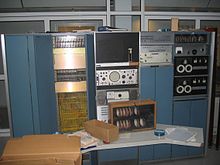PDP-7
The PDP-7 is a mini computer produced by Digital Equipment Corporation (DEC). Introduced in 1965, it was the first computer to use DEC's flip-chip technology. At $ 72,000 (the equivalent of about $ 580,000 today), this computer was very affordable for its processing power. The PDP-7 has a word length of 18 bits, the instruction set is similar to the processors PDP-4 and PDP-9.
In 1969, the computer scientist wrote Ken Thompson , the first Unix - system in assembly language for a PDP-7 processor, which then alluding to the operating system Multics jest Unics was called. It was to become the operating system for the space computer game Space Travel , which required graphics to show the movement of the planets.
A few PDP-7s are still in working order and there is a restoration project in the Norwegian capital, Oslo .
Web links
- http://www.computermuseum-muenchen.de/computer/dec/index.html
- Photos of the PDP-7 ( Memento from August 6, 2011 in the Internet Archive )
Individual evidence
- ↑ The famous PDP-7 comes to the rescue ( English ) Bell Labs . Archived from the original on August 6, 2007. Retrieved October 26, 2011: "It did not take long, therefore, for Thompson to find a little-used PDP-7 computer with an excellent display terminal," Ritchie explained. "He and I rewrote 'Space Travel' to run on this machine."
